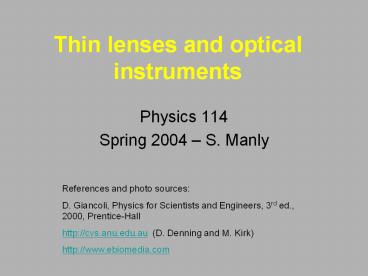Thin lenses and optical instruments - PowerPoint PPT Presentation
Title:
Thin lenses and optical instruments
Description:
References and photo sources: ... Anableps - minnow. Magnifying glass. Refracting telescope. 40 inch refractor Yerkes Observatory ... – PowerPoint PPT presentation
Number of Views:349
Avg rating:3.0/5.0
Title: Thin lenses and optical instruments
1
Thin lenses and optical instruments
- Physics 114
- Spring 2004 S. Manly
References and photo sources D. Giancoli,
Physics for Scientists and Engineers, 3rd ed.,
2000, Prentice-Hall http//cvs.anu.edu.au (D.
Denning and M. Kirk) http//www.ebiomedia.com
2
(No Transcript)
3
(No Transcript)
4
(No Transcript)
5
Power of lens measured in diopters
where f is focal length in meters
Power is positive for converging lenses and
negative for diverging lenses
6
Magnification
Lens equation
7
Real image rays actually pass thru
image Virtual image rays do not actually pass
thru image
Sign convention is the tricky part, especially in
multiple lens systems
- Convention from Giancoli p. 841
- Focal length is for converging lens and - for
diverging lens - Object distance is if on the side of the lens
from which the light is coming (usual, unless in
multi-lens system) - Image distance is if on the opposite side of
the lens from where the light is coming, if on
same side, image distance is - Image distance is for real images and for
virtual images - Height of image is if image is upright and
if image is inverted. Height of object is always
taken to be .
8
(No Transcript)
9
Aberrations
Spherical aberration
Chromatic aberration
10
(No Transcript)
11
(No Transcript)
12
(No Transcript)
13
(No Transcript)
14
A bees eye view
15
(No Transcript)
16
(No Transcript)
17
Anableps - minnow
18
Magnifying glass
19
Refracting telescope
40 inch refractor Yerkes Observatory
20
Reflecting telescope
21
(No Transcript)
22
Keck Observatory
23
Hubble Space Telescope
24
Compound microscope
25
Camera
26
Light vs. depth of field Shutter
speed f-stopf/D, each f-stopfactor of 2 in
light intensity Faster the object or darker the
day, need slower speed and/or larger D Larger D
means narrower depth of field































